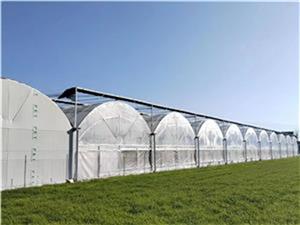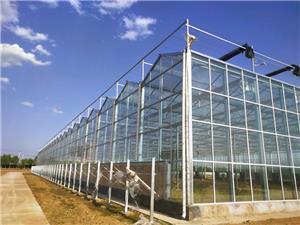Why does tempered glass used in building glass greenhouses self-explode?
Any product will have its own advantages and disadvantages during use. For instance, glass is an essential covering material for building glass greenhouses. Its advantages include a long service life, high light transmittance, and a high-end and elegant appearance. However, glass also has its own drawbacks, with spontaneous breakage being its most significant weakness. The problem of spontaneous breakage of single-layer tempered glass is a common phenomenon regardless of the region of use. As for why tempered glass spontaneously breaks, I have summarized the following four reasons and hope everyone can offer valuable suggestions. When nickel sulfide crystals in tempered glass undergo a phase change, their volume expands. The expansion of nickel sulfide in the tensile stress layer at the core of the glass plate causes greater tensile stress inside the tempered glass. When the tensile stress exceeds the limit that the glass can bear, it will lead to the spontaneous breakage of tempered glass. Foreign research has proved that nickel is brought in by the main raw material of glass, quartz sand or sandstone, and sulfur is brought in by fuel and auxiliary materials. They form nickel sulfide at a high temperature of 1400 to 1500 degrees Celsius in the melting furnace. When the temperature exceeds 1000 degrees Celsius, nickel sulfide exists in the form of droplets randomly distributed in the molten glass. When the temperature drops to 797 degrees Celsius, these small droplets crystallize and solidify, and nickel sulfide is in the high-temperature α-NiS crystal phase (hexagonal crystal). When the temperature continues to drop to 379 degrees Celsius, it undergoes a crystal phase transformation to the low-temperature β-NiS (trigonal crystal system), accompanied by a volume expansion of 2.38%. The speed of this transformation process depends not only on the percentage content of different components (including Ni7S6, NiS, NiS1.01) in the nickel sulfide particles but also on the surrounding temperature. If the phase transformation of nickel sulfide is not complete, even under natural storage and normal use conditions, this process will still continue, although at a very low speed.
The expansion of nickel sulfide inside tempered glass is the main cause of its spontaneous breakage. When tempered glass is heated, the core temperature of the glass is about 620 degrees Celsius, and all nickel sulfide is in the high-temperature α-NiS phase. Subsequently, the glass enters the air blast rapid cooling. The nickel sulfide in the glass undergoes a phase change at 379 degrees Celsius. Unlike the float annealing furnace, the rapid cooling time for tempering is very short, and the nickel sulfide does not have enough time to transform into the low-temperature β-NiS phase but is "frozen" in the glass in the high-temperature α phase. The rapid cooling enables the glass to be tempered, forming a stress-unified balanced body with external compression and internal tension. In the already tempered glass, the phase change of nickel sulfide continues at a low speed, and its volume continuously expands, increasing the force on the surrounding glass. The core of the tempered glass plate itself is a tensile stress layer. When nickel sulfide in this layer undergoes a phase change and expands, it also forms tensile stress. The combination of these two tensile stresses is sufficient to cause the breakage of tempered glass, that is, spontaneous breakage.
Simply put, the nickel element is very small at high temperatures but becomes larger at normal temperatures. During the heating process of tempered glass, the nickel element becomes smaller, but it does not have enough time to return to its normal temperature size during rapid cooling, so tempered glass may spontaneously break. The national standard stipulates that the spontaneous breakage rate of tempered glass is 3‰.
Reasons related to installation technology and installation process
This point is often overlooked. Although the purchased materials are good, if the workers do not install them properly during installation, it can cause uneven force distribution around the tempered glass, easily leading to its spontaneous breakage. Tempered glass has a characteristic that it will not break easily when force is applied to the middle, but if the corners of the tempered glass are slightly stressed, it will cause uneven force distribution and then break. The simplest and most common place is where two water troughs meet. Sometimes, due to installation process issues, there may be a horizontal difference between the upper and lower parts of the two water troughs, causing the glass on both sides of the joint to be easily subjected to uneven force and resulting in spontaneous breakage. Of course, this only occurs in areas with a height difference. Generally, this problem won't appear in the middle part of the entire water channel.
After tempering, the surface layer of the glass forms compressive stress, while the core layer inside is tensile stress. The compressive stress and tensile stress together form a balanced system. Glass is inherently a brittle material, resistant to compression but not tension. Therefore, most of the breakage of glass is caused by tensile stress.
Self-explosion caused by uneven settlement of the foundation
This probability is also quite high. Due to the soil conditions in some areas or poor construction of the foundation, uneven settlement of the foundation may occur after rain or thawing of frozen soil. As long as there is settlement at one point, which cannot be observed by the naked eye, the entire top will also slightly settle. Generally, settlement will cause local horizontal differences, resulting in uneven stress and subsequent self-explosion of the glass. Another cause of settlement is the quality of the backfill soil. When constructing this type of foundation, it must be solid and have increased load-bearing capacity. Once the backfill soil foundation is not done well, it is prone to settlement after rain or thawing of frozen soil.
Self-explosion caused by other reasons
Of course, there are other reasons for the self-explosion of tempered glass. For example, during top maintenance, maintenance personnel may temporarily step on a sharp corner of the tempered glass, or the impact of construction tools may also cause uneven stress on the tempered glass, leading to self-explosion. There may even be other reasons that I have not summarized. I hope everyone can share them.




